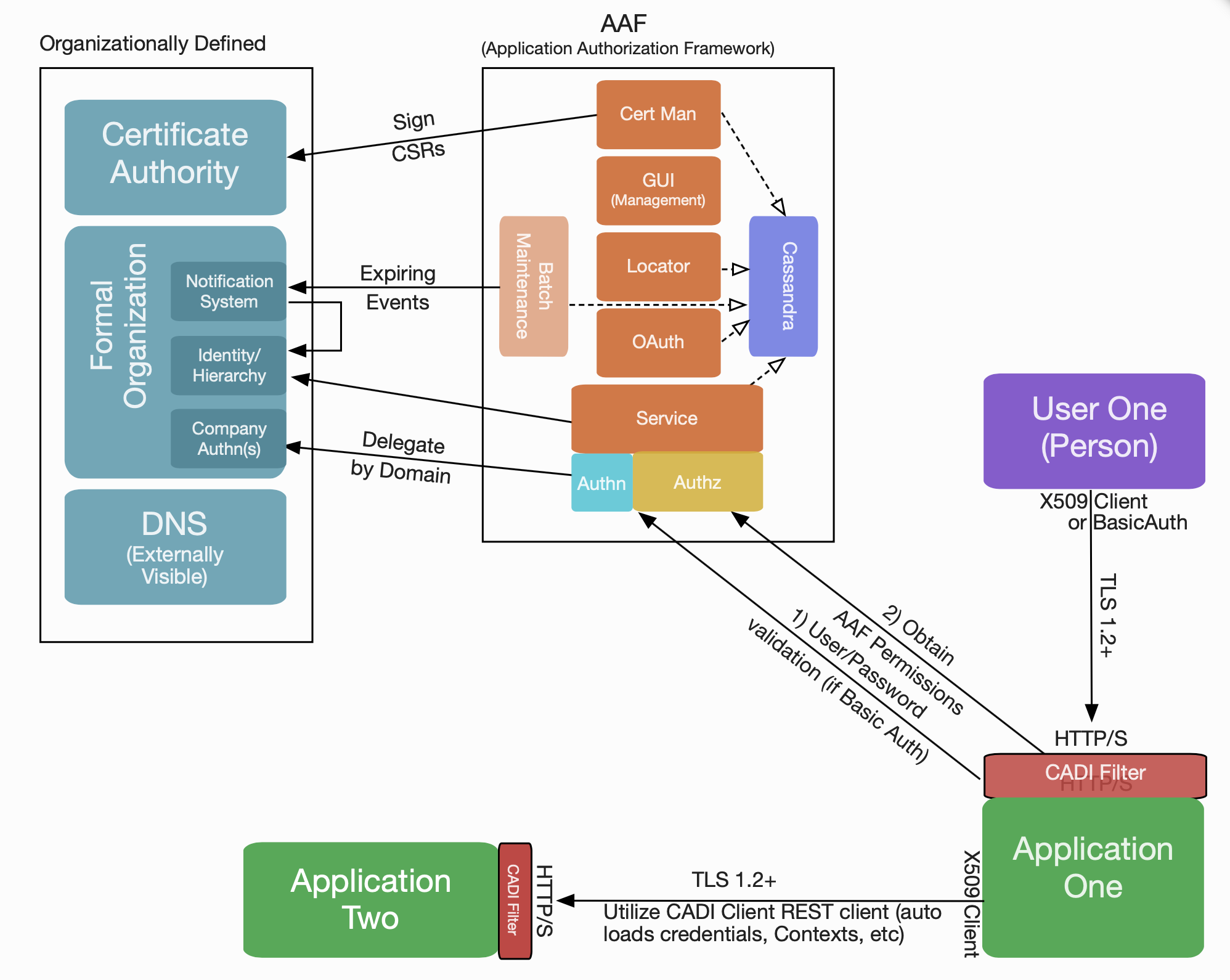PAGE STATUS: UNDER CONSTRUCTION
STATUS: Project Approved (next step is Architecture ApprovalDraft (seeking PTL approval)
AAF (Application Authorization Framework):
1 High Level Component Definition and Architectural Relationships
The AAF functional entity provides authentication, authorization and certificate management services for ONAP components. It provides the capability to:
- Allow each ONAP component to create a namespace to set up their authentication and authorization elements:
- Permissions
- Roles
- Credentials
- Access to organizational identities
- There is a default set of identities each ONAP component for use in ONAP Test Systems
- Store credentials for organizational identities
- Passwords
- AAF provides secure password storage for test/lab use only
- AAF has ability to delegate authentication to external authenticator
- Certificates
- These certificates have unique Authorized Identity embedded, which supports 2 way TLS Authentication
- These certificates can also be used as Server side certificates
- Passwords
- Manage fine grained permissions
- Provide ONAP components or other enforcement points with APP configured permissions
- Manage roles
- AAF provides roles for identities that include any granted permissions
- Validate and provide introspection of OAuth tokens
- Currently unused by ONAP
- Provide locator services through the AAF Locator
- AAF Components and ports can be found globally
- Locator facts
- Locator is not technically restricted to AAF. It can register (protected by Authentication/Authorization) any running process/port/interface
- Registrations include global coordinates, allowing clients to pick the "closest" one
- Locator is independent of any cluster or container mechanisms, which gives accessibility to any network accessible component
- Global - Components can reside anywhere in the world
- Scalable - A new instances can be started anywhere and instantly increase capacity and usage
- "For best results", use Cassandra scaling
- Resilient - VMs, clusters, data centers, K8S could go down, and AAF is still accessible.
- Provide a globally accessible file server to get public security information. For example,
- RCLs
- Root Certificates (any the Organization wants to publish)
- Organizational approved truststores
- Process approvals
- Authorize UI and API requests (REST interface)
- Authenticate users (human and application) (REST interface)
- Manage AAF components (REST interface)
- Auto-Generation of ONAP certificates
- For ONAP test/lab use, AAF Certman provides a local certificate authority (CA)
- AAF Certman can integrate with any certificate authority (CA) that supports the Simple Certificate Enrollment Protocol (SCEP). ONAP does not test this functionality
- Auto-configuration of ONAP certificates for ONAP clients
- as part of "Bare Metal"
- on Docker volumes
Additionally, AAF provides a Java client called CADI, which simplifies AAF use by an ONAP component. The CADI framework is a Java client that:
- Includes all AAF interactions: authentication, authorization, management
- Provides the following authentications: X509, BasicAuth and OAuth
- Provides adapter interfaces for external authenticators
- Includes a Shiro adapter to support ONAP use of ODL
2. API definitions
AAF provides real-time REST interfaces for
- Authorization
- Authentication, if local AAF authentication is used
- Management API for all AAF components, protected by strong authentication and authorization
| draw.io Diagram | ||||||||||||||||||
|---|---|---|---|---|---|---|---|---|---|---|---|---|---|---|---|---|---|---|
|
AAF (Application Authentication Framework) provides the services for authentication, authorization and certificate management for the ONAP components. It provides the services to the ONAP components to manage the lifecycle of authentication and authorization elements such as Permissions, Roles and Credentials. It supports:
- Manage authentication and authorization elements such as: Perminssions, Roles, Credentials
- Access to organizational entities
- Manage the lifecycle of passwords and certificates
- Access to external credential authoriites (e.g. CA)
- Autogenerate ONAP certificates
2. API definitions
AAF provides the following interfaces:CLAMP provides the following REST interfaces: TO BE UPDATED
| Interface Name | Interface Definition | Interface Capabilities |
|---|
| Version | Status | Consumed Models | |
|---|---|---|---|
| AAFE-1 |
| Application Authorization Framework Management Interface |
| A user interface for: |
| |||
| AAFE-2 | Application Authorization Framework Authentication and Authorization Interface | An interface for the ONAP components to:
|
Display and update:
Events received and actions taken on the control loop
|
Note: xxxI interface is a Component internal interface. xxxxE interface is a component external interfaceThe current API documents can be found at:
The provided UI interfaces are found at: CLAMP latest user guide
- CLAMP internal APIs can be found: clamp swagger pdf
AAF Consumes no Interfaces:
| Interface Name | Purpose Reason For Use |
|---|---|
| AAFE-3 |
...
| : AAF External Credential Interface | An interface to retrieve and authenticate using credentials from a credential supplier external to ONAP. |
The current API documents can be found at:
AAFE-1 (to be added)
- AAFE2 (to be added)
- AAFE3 (to be added)
3. Component Description:
Link to read the docs
A more detailed figure and description of the component.
<< For later inclusion >>
4. known system limitations: (IN PROGRESS)
Runtime: None
Clamp data redundancy is dependent on Kubernetes and the persistent volume.
Clamp application redundancy HA relies on Kubernetes
5. Used Models: (N/A)
6. System Deployment Architecture:
...
FFS
AAF consists of x containers:
- CLAMP container
- MariaDB container
- Kibana container
- E_Search container
- LogStash container
draw.io Diagram
7. New Capabilities in this Release
This release, AAF adds the following capabilities:
...
- Internal Kubernetes FQDN generated when client declares its container namespace
- Public FQDN are accessible for both:
- GUIs/Management outside cluster
- Non-ONAP entities outside the cluster
- Other clusters
...
- Example "Helm" init containers to setup volumes
...
- Analysis of expiring credentials and Roles
- Generation of approval records
- Notification of approvals, credentials and roles to support configurable integration with external services.
8. References
- AAF Overview & User Guide: https://onap.readthedocs.io/en/latest/submodules/aaf/authz.git/docs/index.htmlAAF internal interfaces: https://onap.readthedocs.io/en/latest/_downloads/d3c9f924c6586fe411d40a05ad9b1bb7/swagger.pdf
